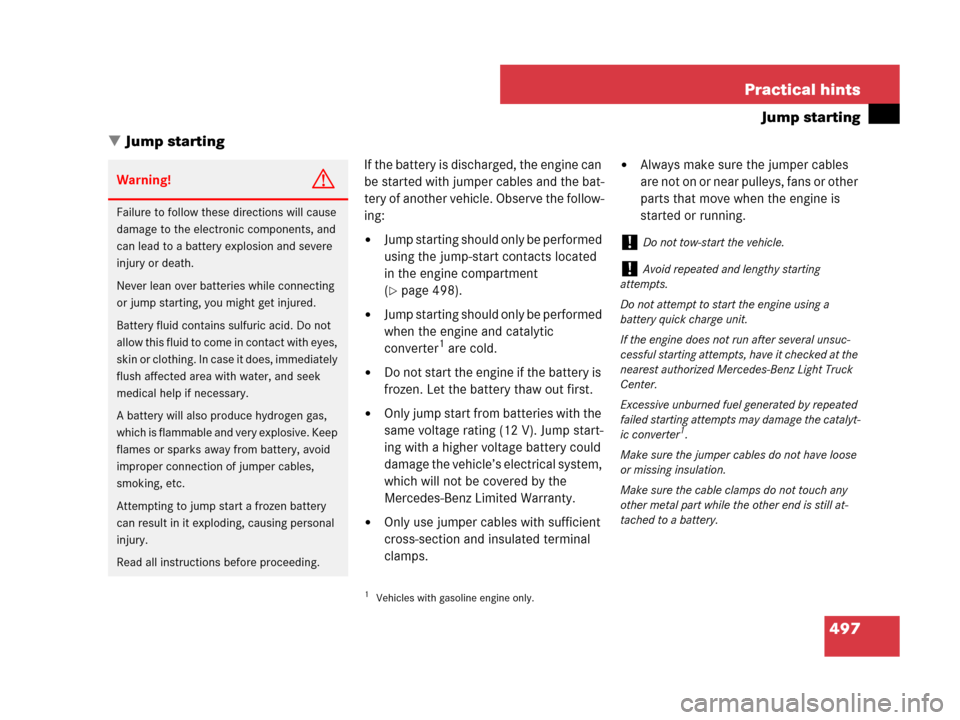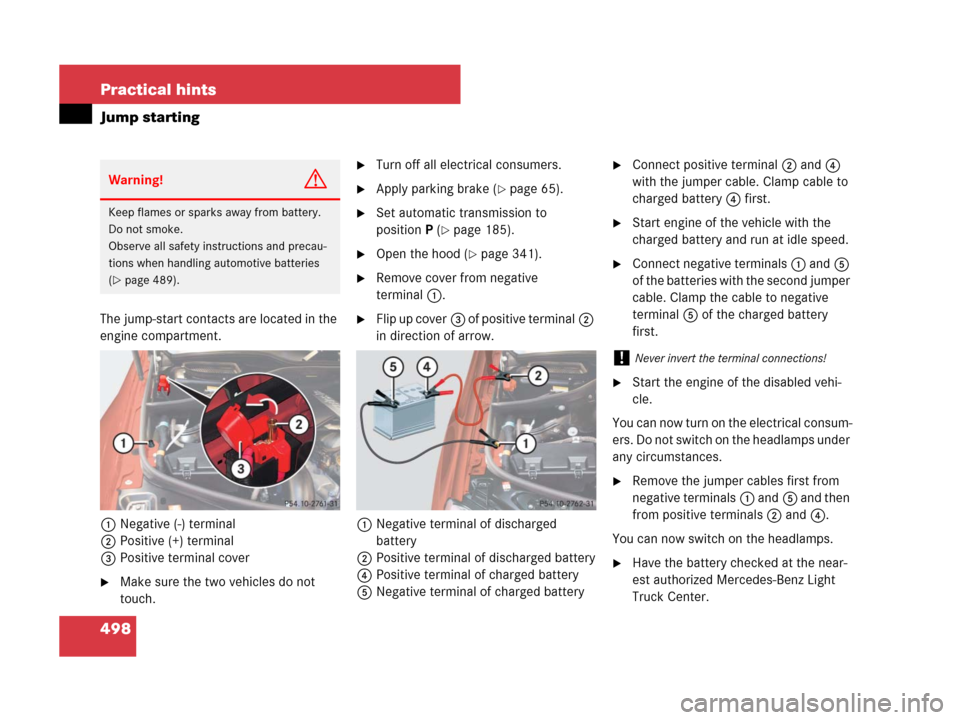Page 491 of 561

490 Practical hints
Battery
!The battery is a valve-regulated lead acid
(VRLA) battery, also referred to as “fleece” bat-
tery. Such batteries do not require topping-up of
the electrolyte level. VRLA batteries therefore do
not have cell caps and the battery cover is
non-removable. Do not attempt to open the bat-
tery as otherwise the battery will be damaged.
Even though VRLA batteries do not require top-
ping-up of the electrolyte level and cannot be
opened to check the electrolyte level, the bat-
tery condition must be checked periodically by
performing a battery conductance test. Refer to
Maintenance Booklet for battery condition test-
ing intervals.
As with any other battery, the battery may dis-
charge if the vehicle is not operated for an ex-
tended period of time. You can connect a battery
maintenance charge unit tested and approved
for use on your vehicle model or disconnect the
battery to prevent battery discharge. Contact an
authorized Mercedes-Benz Light Truck Center
for more information.!The factory-equipped VRLA battery is
leak-proofed. Only use a battery as replacement
that has the same security features and is of
identical size, voltage, and capacity as the
factory-equipped battery.
The battery, the battery ventilation hose
(
�page 495) and the lateral plug (�page 495)
must always be securely installed when the
vehicle is in operation.
Warning!G
Jump starting must only be done using the
jump-start contacts located in the engine
compartment (
�page 497).
Warning!G
Failure to follow these instructions can re-
sult in severe injury or death.
Observe all safety instructions and precau-
tions when handling automotive batteries
(
�page 489).
Never lean over batteries while connecting,
you might get injured.
Battery fluid contains sulfuric acid. Do not
allow this fluid to come in contact with eyes,
skin or clothing. In case it does, immediately
flush affected area with water and seek
medical help if necessary.
A battery will also produce hydrogen gas,
which is flammable and explosive. Keep
flames or sparks away from battery, avoid
improper connection of jumper cables,
smoking etc.
Page 498 of 561

497 Practical hints
Jump starting
�Jump starting
If the battery is discharged, the engine can
be started with jumper cables and the bat-
tery of another vehicle. Observe the follow-
ing:
�Jump starting should only be performed
using the jump-start contacts located
in the engine compartment
(
�page 498).
�Jump starting should only be performed
when the engine and catalytic
converter
1 are cold.
�Do not start the engine if the battery is
frozen. Let the battery thaw out first.
�Only jump start from batteries with the
same voltage rating (12 V). Jump start-
ing with a higher voltage battery could
damage the vehicle’s electrical system,
which will not be covered by the
Mercedes-Benz Limited Warranty.
�Only use jumper cables with sufficient
cross-section and insulated terminal
clamps.
�Always make sure the jumper cables
are not on or near pulleys, fans or other
parts that move when the engine is
started or running.
Warning!G
Failure to follow these directions will cause
damage to the electronic components, and
can lead to a battery explosion and severe
injury or death.
Never lean over batteries while connecting
or jump starting, you might get injured.
Battery fluid contains sulfuric acid. Do not
allow this fluid to come in contact with eyes,
skin or clothing. In case it does, immediately
flush affected area with water, and seek
medical help if necessary.
A battery will also produce hydrogen gas,
which is flammable and very explosive. Keep
flames or sparks away from battery, avoid
improper connection of jumper cables,
smoking, etc.
Attempting to jump start a frozen battery
can result in it exploding, causing personal
injury.
Read all instructions before proceeding.
1Vehicles with gasoline engine only.
!Do not tow-start the vehicle.
!Avoid repeated and lengthy starting
attempts.
Do not attempt to start the engine using a
battery quick charge unit.
If the engine does not run after several unsuc-
cessful starting attempts, have it checked at the
nearest authorized Mercedes-Benz Light Truck
Center.
Excessive unburned fuel generated by repeated
failed starting attempts may damage the catalyt-
ic converter
1.
Make sure the jumper cables do not have loose
or missing insulation.
Make sure the cable clamps do not touch any
other metal part while the other end is still at-
tached to a battery.
Page 499 of 561

498 Practical hints
Jump starting
The jump-start contacts are located in the
engine compartment.
1Negative (-) terminal
2Positive (+) terminal
3Positive terminal cover
�Make sure the two vehicles do not
touch.
�Turn off all electrical consumers.
�Apply parking brake (�page 65).
�Set automatic transmission to
positionP (
�page 185).
�Open the hood (�page 341).
�Remove cover from negative
terminal1.
�Flip up cover3 of positive terminal2
in direction of arrow.
1Negative terminal of discharged
battery
2Positive terminal of discharged battery
4Positive terminal of charged battery
5Negative terminal of charged battery
�Connect positive terminal2 and4
with the jumper cable. Clamp cable to
charged battery4 first.
�Start engine of the vehicle with the
charged battery and run at idle speed.
�Connect negative terminals1 and5
of the batteries with the second jumper
cable. Clamp the cable to negative
terminal5 of the charged battery
first.
�Start the engine of the disabled vehi-
cle.
You can now turn on the electrical consum-
ers. Do not switch on the headlamps under
any circumstances.
�Remove the jumper cables first from
negative terminals1 and5 and then
from positive terminals2 and4.
You can now switch on the headlamps.
�Have the battery checked at the near-
est authorized Mercedes-Benz Light
Truck Center.
Warning!G
Keep flames or sparks away from battery.
Do not smoke.
Observe all safety instructions and precau-
tions when handling automotive batteries
(
�page 489).
!Never invert the terminal connections!